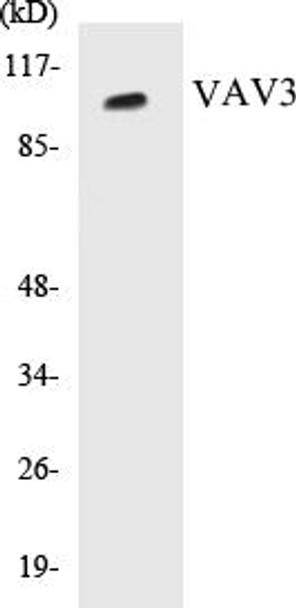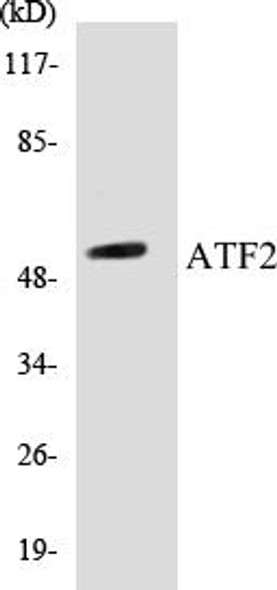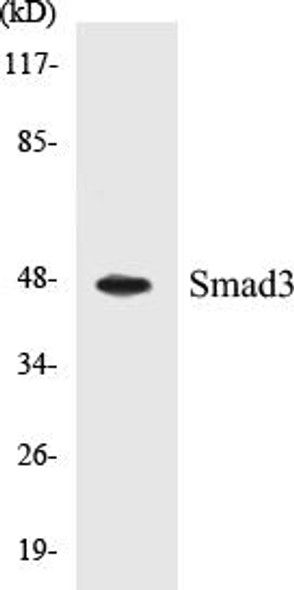Cardiovascular
VAV3 Colorimetric Cell-Based ELISA Kit
- SKU:
- CBCAB00901
- Product Type:
- ELISA Kit
- ELISA Type:
- Cell Based
- Research Area:
- Cardiovascular
- Reactivity:
- Human
- Reactivity:
- Mouse
- Detection Method:
- Colorimetric
Description
| Product Name: | VAV3 Colorimetric Cell-Based ELISA |
| Product Code: | CBCAB00901 |
| ELISA Type: | Cell-Based |
| Target: | VAV3 |
| Reactivity: | Human, Mouse |
| Dynamic Range: | > 5000 Cells |
| Detection Method: | Colorimetric 450 nmStorage/Stability:4°C/6 Months |
| Format: | 96-Well Microplate |
The VAV3 Colorimetric Cell-Based ELISA Kit is a convenient, lysate-free, high throughput and sensitive assay kit that can detect VAV3 protein expression profile in cells. The kit can be used for measuring the relative amounts of VAV3 in cultured cells as well as screening for the effects that various treatments, inhibitors (ie siRNA or chemicals), or activators have on VAV3.
Qualitative determination of VAV3 concentration is achieved by an indirect ELISA format. In essence, VAV3 is captured by VAV3-specific primary antibodies while the HRP-conjugated secondary antibodies bind the Fc region of the primary antibody. Through this binding, the HRP enzyme conjugated to the secondary antibody can catalyze a colorimetric reaction upon substrate addition. Due to the qualitative nature of the Cell-Based ELISA, multiple normalization methods are needed:
| 1. | A monoclonal antibody specific for human GAPDH is included to serve as an internal positive control in normalizing the target absorbance values. |
| 2. | Following the colorimetric measurement of HRP activity via substrate addition, the Crystal Violet whole-cell staining method may be used to determine cell density. After staining, the results can be analysed by normalizing the absorbance values to cell amounts, by which the plating difference can be adjusted. |
| Database Information: | Gene ID: 10451, UniProt ID: Q9UKW4, OMIM: 605541, Unigene: Hs.267659 |
| Gene Symbol: | VAV3 |
| Sub Type: | None |
| UniProt Protein Function: | VAV3: a guanine nucleotide exchange factor (GEF) that activates RhoA, RhoG and, to a lesser extent, Rac1. Binds physically to the nucleotide-free states of those GTPases. Plays an important role in angiogenesis. Its recruitment by activated EPHA2 is critical for EFNA1-induced RAC1 GTPase activation and vascular endothelial cell migration and assembly. May be important for integrin-mediated signaling, at least in some cell types. In osteoclasts, along with SYK tyrosine kinase, required for signaling through integrin alpha-v/beta-1 (ITAGV-ITGB1), a crucial event for osteoclast proper cytoskeleton organization and function. This signaling pathway involves RAC1, but not RHO, activation. Necessary for proper wound healing. In the course of wound healing, required for the phagocytotic cup formation preceding macrophage phagocytosis of apoptotic neutrophils. Responsible for integrin beta-2 (ITGB2)-mediated macrophage adhesion and, to a lesser extent, contributes to beta-3 (ITGB3)-mediated adhesion. Does not affect integrin beta-1 (ITGB1)-mediated adhesion. Interacts with the PH domain of APS. Interacts (via SH2 domains) with the phosphorylated form of EPHA2. Interacts with ROS1; constitutive interaction that mediates VAV3 phosphorylation. Down-regulated by EGF and TGF-beta. Four isoforms of the human protein are produced by alternative promoter. Isoform 1 and isoform 3 are widely expressed; both are expressed at very low levels in skeletal muscle. In keratinocytes, isoform 1 is less abundant than isoform 3. Isoform 3 is detected at very low levels, if any, in adrenal gland, bone marrow, spleen, fetal brain and spinal chord; in these tissues, isoform 1 is readily detectable. |
| UniProt Protein Details: | Protein type:Nuclear receptor co-regulator; Actin-binding; Motility/polarity/chemotaxis; Adaptor/scaffold; GEFs, Rac/Rho; GEFs Chromosomal Location of Human Ortholog: 1p13.3 Cellular Component: cytosol; plasma membrane Molecular Function:epidermal growth factor receptor binding; GTPase activator activity; guanyl-nucleotide exchange factor activity; metal ion binding; protein binding; Rac guanyl-nucleotide exchange factor activity; SH3/SH2 adaptor activity Biological Process: angiogenesis; axon guidance; B cell receptor signaling pathway; blood coagulation; ephrin receptor signaling pathway; innate immune response; integrin-mediated signaling pathway; lamellipodium biogenesis; nerve growth factor receptor signaling pathway; neutrophil chemotaxis; platelet activation; positive regulation of apoptosis; positive regulation of B cell proliferation; positive regulation of cell adhesion; positive regulation of GTPase activity; positive regulation of phosphoinositide 3-kinase activity; positive regulation of signal transduction; regulation of cell size; regulation of GTPase activity; regulation of Rho protein signal transduction; regulation of small GTPase mediated signal transduction; response to DNA damage stimulus; response to drug; small GTPase mediated signal transduction; vascular endothelial growth factor receptor signaling pathway; vesicle fusion |
| NCBI Summary: | This gene is a member of the VAV gene family. The VAV proteins are guanine nucleotide exchange factors (GEFs) for Rho family GTPases that activate pathways leading to actin cytoskeletal rearrangements and transcriptional alterations. This gene product acts as a GEF preferentially for RhoG, RhoA, and to a lesser extent, RAC1, and it associates maximally with the nucleotide-free states of these GTPases. Alternatively spliced transcript variants encoding different isoforms have been described for this gene. [provided by RefSeq, Jul 2008] |
| UniProt Code: | Q9UKW4 |
| NCBI GenInfo Identifier: | 12643372 |
| NCBI Gene ID: | 10451 |
| NCBI Accession: | Q9UKW4.1 |
| UniProt Secondary Accession: | Q9UKW4,O60498, O95230, Q9Y5X8, B1AMM0, B1APV5, B4E232 B7ZLR1, E9PQ97, |
| UniProt Related Accession: | Q9UKW4 |
| Molecular Weight: | 100,828 Da |
| NCBI Full Name: | Guanine nucleotide exchange factor VAV3 |
| NCBI Synonym Full Names: | vav guanine nucleotide exchange factor 3 |
| NCBI Official Symbol: | VAV3 |
| NCBI Protein Information: | guanine nucleotide exchange factor VAV3 |
| UniProt Protein Name: | Guanine nucleotide exchange factor VAV3 |
| Protein Family: | Guanine nucleotide exchange factor |
| UniProt Gene Name: | VAV3 |
| UniProt Entry Name: | VAV3_HUMAN |
| Component | Quantity |
| 96-Well Cell Culture Clear-Bottom Microplate | 2 plates |
| 10X TBS | 24 mL |
| Quenching Buffer | 24 mL |
| Blocking Buffer | 50 mL |
| 15X Wash Buffer | 50 mL |
| Primary Antibody Diluent | 12 mL |
| 100x Anti-Phospho Target Antibody | 60 µL |
| 100x Anti-Target Antibody | 60 µL |
| Anti-GAPDH Antibody | 60 µL |
| HRP-Conjugated Anti-Rabbit IgG Antibody | 12 mL |
| HRP-Conjugated Anti-Mouse IgG Antibody | 12 mL |
| SDS Solution | 12 mL |
| Stop Solution | 24 mL |
| Ready-to-Use Substrate | 12 mL |
| Crystal Violet Solution | 12 mL |
| Adhesive Plate Seals | 2 seals |
The following materials and/or equipment are NOT provided in this kit but are necessary to successfully conduct the experiment:
- Microplate reader able to measure absorbance at 450 nm and/or 595 nm for Crystal Violet Cell Staining (Optional)
- Micropipettes with capability of measuring volumes ranging from 1 µL to 1 ml
- 37% formaldehyde (Sigma Cat# F-8775) or formaldehyde from other sources
- Squirt bottle, manifold dispenser, multichannel pipette reservoir or automated microplate washer
- Graph paper or computer software capable of generating or displaying logarithmic functions
- Absorbent papers or vacuum aspirator
- Test tubes or microfuge tubes capable of storing ≥1 ml
- Poly-L-Lysine (Sigma Cat# P4832 for suspension cells)
- Orbital shaker (optional)
- Deionized or sterile water
*Note: Protocols are specific to each batch/lot. For the correct instructions please follow the protocol included in your kit.
| Step | Procedure |
| 1. | Seed 200 µL of 20,000 adherent cells in culture medium in each well of a 96-well plate. The plates included in the kit are sterile and treated for cell culture. For suspension cells and loosely attached cells, coat the plates with 100 µL of 10 µg/ml Poly-L-Lysine (not included) to each well of a 96-well plate for 30 minutes at 37°C prior to adding cells. |
| 2. | Incubate the cells for overnight at 37°C, 5% CO2. |
| 3. | Treat the cells as desired. |
| 4. | Remove the cell culture medium and rinse with 200 µL of 1x TBS, twice. |
| 5. | Fix the cells by incubating with 100 µL of Fixing Solution for 20 minutes at room temperature. The 4% formaldehyde is used for adherent cells and 8% formaldehyde is used for suspension cells and loosely attached cells. |
| 6. | Remove the Fixing Solution and wash the plate 3 times with 200 µL 1x Wash Buffer for five minutes each time with gentle shaking on the orbital shaker. The plate can be stored at 4°C for a week. |
| 7. | Add 100 µL of Quenching Buffer and incubate for 20 minutes at room temperature. |
| 8. | Wash the plate 3 times with 1x Wash Buffer for 5 minutes each time. |
| 9. | Add 200 µL of Blocking Buffer and incubate for 1 hour at room temperature. |
| 10. | Wash 3 times with 200 µL of 1x Wash Buffer for 5 minutes each time. |
| 11. | Add 50 µL of 1x primary antibodies (Anti-VAV3 Antibody and/or Anti-GAPDH Antibody) to the corresponding wells, cover with Parafilm and incubate for 16 hours (overnight) at 4°C. If the target expression is known to be high, incubate for 2 hours at room temperature. |
| 12. | Wash 3 times with 200 µL of 1x Wash Buffer for 5 minutes each time. |
| 13. | Add 50 µL of 1x secondary antibodies (HRP-Conjugated AntiRabbit IgG Antibody or HRP-Conjugated Anti-Mouse IgG Antibody) to corresponding wells and incubate for 1.5 hours at room temperature. |
| 14. | Wash 3 times with 200 µL of 1x Wash Buffer for 5 minutes each time. |
| 15. | Add 50 µL of Ready-to-Use Substrate to each well and incubate for 30 minutes at room temperature in the dark. |
| 16. | Add 50 µL of Stop Solution to each well and read OD at 450 nm immediately using the microplate reader. |
(Additional Crystal Violet staining may be performed if desired – details of this may be found in the kit technical manual.)






